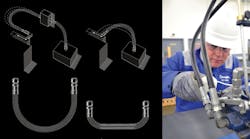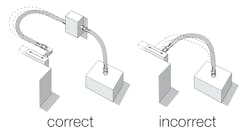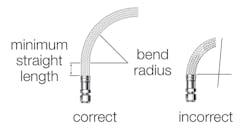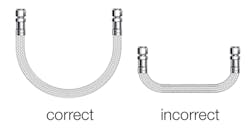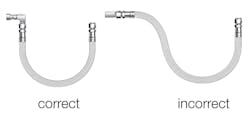Every plant seeks to avoid downtime and safety risks. Industrial hoses are a critical part of accomplishing those goals. Here are four simple ways to keep them safe and working:
Match hose type to application. Increasing production often puts greater demand—and stresses—on industrial hoses. In cases of high demand, make sure hose specifications for pressure, temperature, and chemical compatibility are up-to-date and inspected regularly. When specifying a hose, follow the considerations outlined in this article to ensure the hose type is properly matched to its intended application.
Properly route hoses to eliminate strains. Even if all the right choices have been made in choosing the right the hose material and type for its given application, improper installation and routing can cause hose failures and, in turn, greater risks to workers and equipment.
One common installation error involves improper hose length. If the hose is too long, it can lead to accelerated wear from rubbing against itself or a machine. Inversely, if it is too short, stretching it too far to make it fit can create leaks at the end connections as a result of regular operating conditions such as thermal expansion, pressure changes, or other movements. The proper hose length has enough slack to handle connection point movement, but not enough to allow for rubbing, interference, or kinking.
Some other common strain sources include:
Twisting a hose or bending it in more than one plane.
Bending the hose beyond its recommended minimum radius.
Bending too close to the hose/fitting connection.
Hose is too short and is strained during impulses.
Failing to use elbows and adapters to relive hose strain on horizontal end connections.
Perform proactive maintenance. In most cases, hose failures can be predicted. All industrial hoses should be checked and replaced at regular intervals, based on hose type and function. Operators should follow a schedule of regular, visual hose inspections, examining each hose at intervals recommended by the supplier. During these inspections, look for signs of wear, such as scrapes, cuts, corrosion, kinks, and general deterioration.
Individual maintenance schedules depend on the specific application, and some hose materials wear faster than others. In any case, repetitive movement, vibrations, pressure impulses, and improper routing can all lead to premature wear.
Store hoses properly. Keep these tips in mind when it comes to storing hoses:
- Store in clean, dry conditions at temperatures between 50° and 70°F (10° to 21°C).
- Protect from UV light and sunlight.
- Cap the hose at both ends to prevent contamination.
- Hang hoses so they are not bending beyond the manufacturer’s recommended minimum bend radius.
- Do not stack hoses.
- Store coils horizontally on a surface as the weight of the coils may indent the hose in several places if hung from a hook.
Bill Menz is market manager for hoses at Swagelok Co. (www.swagelok.com/en/contact-us).
